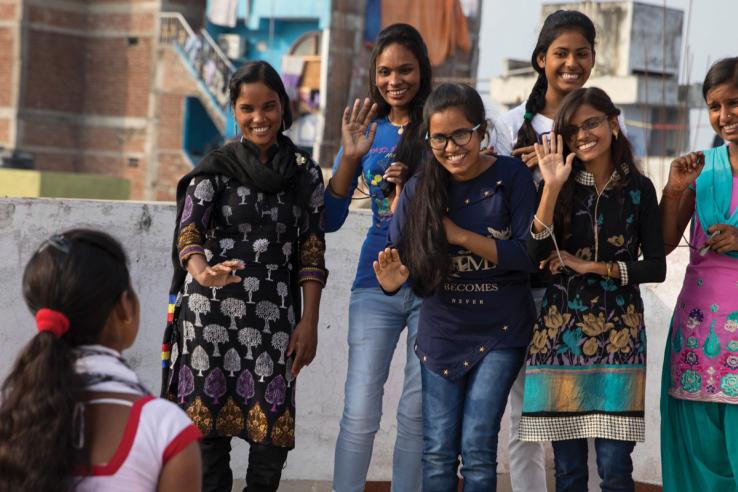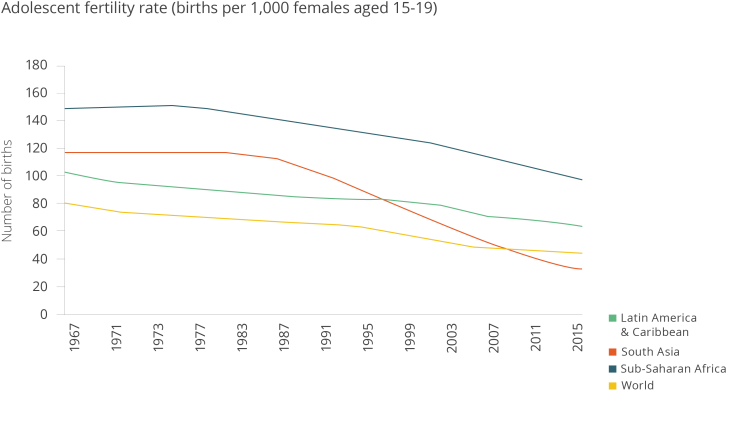Reducing adolescent pregnancy by increasing educational and economic opportunities in low- and middle-income countries

Résumé
In 2018, 21 million girls and young women aged 15 to 19 in developing regions were expected to become pregnant.1 Nearly half (49 percent) of all adolescent pregnancies in developing regions were unintended as of 2016, meaning that the pregnancy occurred earlier than girls and young women wanted or when they didn’t want it at all.2 Pregnant adolescents face a higher risk of maternal mortality than women in their twenties,3 and their babies are more often born prematurely, weigh less, and are more susceptible to neonatal and infant death.
A review of eight randomized evaluations in eight low- and middle-income countries illustrates that programs that encouraged girls and young women to go to school longer and to develop their vocational and life skills delayed pregnancy. The programs that were effective helped girls and young women delay childbirth through a combination of strengthening beliefs that good educational and economic opportunities exist for girls and young women and improving their access to these opportunities. Policymakers interested in supporting adolescent girls and women in delaying childbirth should improve access to education and training programs that build girls’ capacity to pursue opportunities, or invest in information programs that amplify participants’ perceptions of available opportunities.

Résultats
Programs that strengthen beliefs about girls’ and young women’s abilities and future economic opportunities led them to delay childbearing. Adolescents who hold positive beliefs about their future economic opportunities may be more likely to engage in productive educational and economic activities and avoid risky sexual behavior.
In India, recruiters visited villages to share information on job opportunities in call centers. Girls and young women in these villages were more likely to state an expectation to work when not raising children and reported wanting fewer children [1]. The accompanying delays in childbirth among this group reflected these raised expectations. Girls and women aged 15 to 21 in villages visited by recruiters were 5.7 percentage points (13 percent) less likely to have given birth three years later, relative to 43 percent among those in the comparison group who did not live in visited areas. In the Dominican Republic, adolescents who completed a national youth training program held more optimistic expectations about their future and they delayed childbirth, likely to pursue opportunities they considered achievable [2]. Eighteen to 24 months after graduation from the program, girls and young women aged 16 to 19 were 7.8 percentage points (20 percent) less likely to have become pregnant, relative to 39 percent of the comparison group.
Empowerment programs that aim to develop girls’ and young women’s agency over their lives and bodies through training, information, and access to resources have not demonstrated consistent impacts on adolescent pregnancy. While empowerment programs vary considerably, many provide a mix of skills development, information, and vocational training and involve regular meetings in safe spaces led by community mentors.
In Uganda, an empowerment program that included livelihoods training proved effective in delaying childbearing four years after the end of the program [3]. Participants reported stronger beliefs in their entrepreneurial activity and were more likely to engage in income-generating activities. In addition, they were 3.8 percentage points (34 percent) less likely to have any children than girls and young women in the comparison group. In this case, the impact of the increased aspirations cannot be disentangled from the impact of the program overall.
In contrast, in Bangladesh [4] and Tanzania [5], empowerment programs had no impact on pregnancy. In Bangladesh, this may partly reflect the fact higher level of control that parents exert over girls’ and young women’s marital and reproductive decisions than in Uganda [3]. In Tanzania, implementation constraints may have undermined the program’s impact; the program lacked the resources to secure safe spaces, provide materials, or train mentors [5]. For policymakers interested in specifically reducing pregnancy rates among adolescents, more research is needed to understand how to structure empowerment curriculums to achieve this policy goal.
Subsidies and scholarships that enabled girls to stay in school delayed pregnancy. Education could impact pregnancy rates in several ways. First, adolescents may choose to invest in more education and avoid pregnancy in order to earn higher future wages. Second, schooling may help adolescents better process their decisions related to sexual behaviors and childbirth. Third, educational attainment may shape fertility preferences.
Existing evidence shows that continuing school is highly sensitive to costs of attendance; reducing these costs helped girls and young women stay enrolled. In Kenya, secondary students received free uniforms, which are mandatory and otherwise pose a cost to households [6]. Pregnancy rates fell because the subsidy helped girls avoid dropping out and settling into committed relationships. In Ghana, students accepted to secondary school were awarded scholarships [7]. Rates of pregnancy before age 25 among scholarship winners fell by 10.7 percentage points (18 percent) compared to girls who did not receive the scholarship.
Conditional cash transfers also encouraged girls and young women to continue their schooling. In Malawi, cash transfer incentives conditional on school enrollment delayed childbirth among adolescents that had previously dropped out of school [8]. Recipients who were not enrolled in school at the start of the program, but who were assigned to the conditional cash transfer treatment group, were 8.1 percentage points (10 percent) less likely to have become pregnant compared to adolescents who did not receive conditional transfers. The conditional cash transfers were highly effective in allowing out-of-school adolescents to return to school. However, there was no impact among girls who already attended school before the start of the transfers. For cash transfer programs to decrease pregnancy rates by increasing education, the impact on educational outcomes must be relatively large.
Policymakers interested in encouraging girls to continue education should reduce or eliminate any monetary costs families incur by sending their daughters to school, which in turn could, in turn, lead to decreases in adolescent pregnancy.
Parental decisions around their daughters’ educational and economic opportunities can be important determinants of their pregnancy outcomes. In Bangladesh, an empowerment program may not have affected pregnancy outcomes due to the high level of control that parents exert over girls’ and young women’s marital and reproductive decisions [4]. In India [1], visits by call center recruiters changed parents’ expectations of their daughters’ economic opportunities. Parents increased investments in their younger daughters’ education and health, leading to higher school enrollment and BMI-for-age scores (a prominent nutrition indicator). In contexts where parents and others influence adolescent females’ childbearing outcomes, programs should involve and take into account the considerations of these decision-makers.
Abdul Latif Jameel Poverty Action Lab (J-PAL). 2019. "Reducing adolescent pregnancy by increasing educational and economic opportunities in low- and middle-income countries." J-PAL Policy Insights. http://doi.org/10.31485/pi.2392.2019.
World Health Organization. 2018.Adolescent Pregnancy (Fact sheet No. 364). Geneva: World Health Organization (WHO). http://www.who.int/mediacentre/factsheets/fs364/en/.
Darroch, Jacqueline E., Vanessa Woog, Akinrinola Bankole, and Lori S. Ashford. 2016. Adding it up: Costs and Benefits of Meeting the Contraceptive Needs of Adolescents. New York: Guttmacher Institute.
Nove, Andrea, Zoë Matthews, Sarah Neal, and Alma Virginia Camacho. 2012. “Maternal Mortality in Adolescents Compared with Women of Other Ages: Evidence from 144 Countries.” The Lancet Global Health 2 (155).
Jensen, Robert. 2012. “Do Labor Market Opportunities Affect Young Women’s Work and Family Decisions? Experimental Evidence from India.” The Quarterly Journal of Economics 127 (2): 753–92. Research Paper | J-PAL Evaluation Summary
Ibarraran, Pablo, Laura Ripani, Bibiana Taboada, Juan Miguel Villa, and Brigida Garcia. 2014. “Life Skills, Employability and Training for Disadvantaged Youth: Evidence from a Randomized Evaluation Design.” IZA Journal of Labor & Development 3 (10): 1–24. Research Paper
Novella, Rafael, and Laura Ripani. 2016. “Are You (Not) Expecting? The Unforeseen Benefits of Job Training on Teenage Pregnancy.” IZA Journal of Labor & Development 19 (5): 1-18. Research Paper
Bandiera, Oriana, Niklas Buehren, Robin Burgess, Markus Goldstein, Selim Gulesci, Imran Rasul, and Munshi Sulaiman. “Women’s Empowerment in Action: Evidence from a Randomized Control Trial in Africa.” Working Paper, 2018. Research Paper | J-PAL Evaluation Summary
Buchmann, Nina, Erica Field, Rachel Glennerster, Shahana Nazneen, Svetlana Pimkina, and Iman Sen. “Power vs. Money: Alternative Approaches to Reducing Child Marriage in Bangladesh, a Randomized Control Trial.” Working Paper, 2018. Research Paper | J-PAL Evaluation Summary
Buehren, Niklas, Markus Goldstein, Selim Gulesci, Munshi Sulaiman, and Venus Yam. “Evaluation of Layering Microfinance on an Adolescent Development Program for Girls in Tanzania.” Research Working Paper No. 7961, Washington, DC, 2017. Research Paper
Duflo, Esther, Pascaline Dupas, and Michael Kremer. 2015. “Education, HIV, and Early Fertility: Experimental Evidence from Kenya.” American Economic Review 105 (9): 2757–97. Research Paper | J-PAL Evaluation Summary
Duflo, Esther, Pascaline Dupas, and Michael Kremer. “The Impact of Free Secondary Education: Experimental Evidence from Ghana,” Working paper, 2017. Research Paper | J-PAL Evaluation Summary
Baird, Sarah, Craig McIntosh, and Berk Özler. 2019. “When the Money Runs Out: Do Cash Transfers Have Sustained Effects on Human Capital Accumulation?” Journal of Development Economics 140: 169–185. Research Paper | J-PAL Evaluation Summary